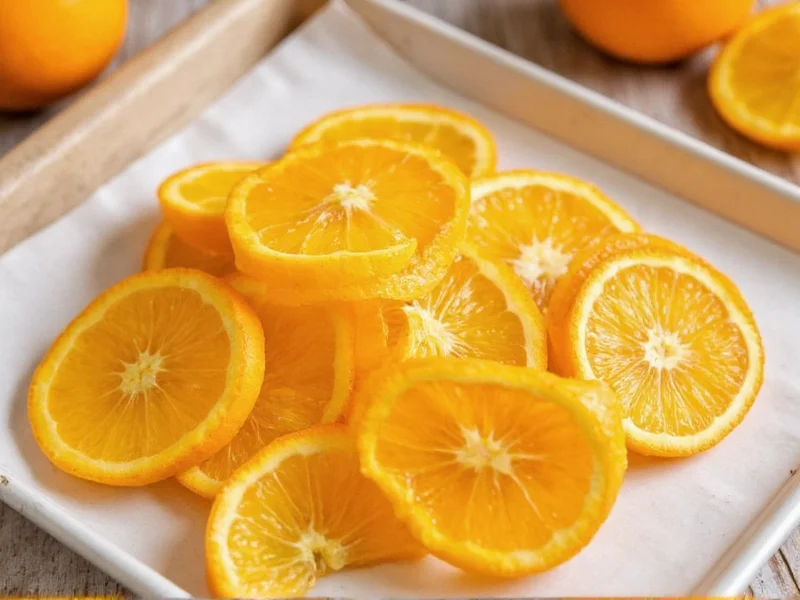Drying orange peels transforms kitchen scraps into versatile ingredients for cooking, crafts, and natural remedies. This comprehensive guide covers proven methods that ensure optimal results whether you're preserving citrus zest for baking or creating aromatic decorations.
Why Preserve Orange Peels?
Orange peels contain valuable oils and compounds that concentrate when dried. Properly dried peels maintain their citrus fragrance for months and offer multiple practical applications:
- Enhance baked goods and spice blends with intense citrus flavor
- Create natural air fresheners and potpourri
- Brew soothing herbal teas
- Make homemade cleaning solutions
- Develop natural insect repellents
Preparing Orange Peels for Drying
Start with quality preparation to ensure successful drying:
- Select fresh oranges - Choose organic fruit to avoid pesticide residues. Wash thoroughly with a vegetable brush.
- Remove white pith - Use a vegetable peeler or paring knife to separate the colored zest from the bitter white membrane.
- Cut uniformly - Slice peels into 1/4-inch strips for even drying. Thinner pieces dry faster but may become brittle.
- Blanch optional - For sweeter flavor, briefly boil peels for 2 minutes then plunge into ice water.
Three Effective Drying Methods Compared
| Method | Temperature | Time Required | Best For |
|---|---|---|---|
| Food Dehydrator | 125°F (52°C) | 6-12 hours | Consistent results, energy efficient |
| Oven Drying | 170°F (77°C) | 2-4 hours | Quick results, no special equipment |
| Air Drying | Room temperature | 3-7 days | Preserving volatile oils, no energy cost |
Step-by-Step Drying Instructions
Using a Food Dehydrator (Best Results)
This method preserves maximum flavor and color while preventing mold:
- Arrange peel strips in a single layer on dehydrator trays without overlapping
- Set temperature to 125°F (52°C) - higher temperatures degrade essential oils
- Rotate trays every 2 hours for even drying
- Check after 6 hours - peels should be brittle with no moisture remaining
- Continue drying in 30-minute increments until completely dry
Oven Drying (Fastest Method)
Perfect when you need dried peels quickly:
- Preheat oven to its lowest setting (typically 170°F/77°C)
- Line baking sheets with parchment paper
- Spread peels in single layer, ensuring space between pieces
- Prop oven door open 2-3 inches with a wooden spoon
- Check every 30 minutes after first hour
- Remove when peels snap cleanly rather than bend
Air Drying (Traditional Method)
Ideal for preserving delicate citrus aromas:
- Place peels on wire racks to allow air circulation
- Choose a warm, dry location away from direct sunlight
- Cover with cheesecloth to prevent dust accumulation
- Turn peels daily for even drying
- Complete drying typically takes 3-7 days depending on humidity
Testing for Complete Dryness
Properly dried orange peels should exhibit these characteristics:
- Texture - Brittle and snaps when bent (not leathery or flexible)
- Color - Deepened orange hue without dark spots
- Moisture - No visible moisture when broken
- Smell - Strong citrus aroma without mustiness
Under-dried peels develop mold during storage. If peels bend without breaking, return them to the drying method for additional time.
Storing Dried Orange Peels Properly
Maximize shelf life with these storage techniques:
- Allow peels to cool completely before storing
- Use airtight glass containers or vacuum-sealed bags
- Store in a cool, dark place away from heat sources
- Add silica gel packets to absorb residual moisture
- Label containers with date (properly stored peels last 6-12 months)
Check stored peels monthly for moisture or mold. Discard immediately if any signs appear.
Creative Uses for Your Dried Orange Peels
Transform your preserved citrus into practical household items:
Culinary Applications
- Grind into orange zest powder for baking and spice rubs
- Infuse in sugar for citrus-flavored sweetener
- Add to tea blends for natural flavoring
- Create homemade orange extract by steeping in vodka
Home and Wellness Uses
- Simmer with cinnamon sticks for natural air freshener
- Combine with cloves for winter potpourri
- Mix with vinegar for all-purpose cleaner
- Add to bathwater for aromatherapy experience
Troubleshooting Common Drying Issues
Mold Development
Cause: Insufficient drying or high humidity during storage
Solution: Increase drying time by 25%, use silica gel in storage containers, ensure proper air circulation during drying
Browning or Dark Spots
Cause: Oven temperature too high or exposure to direct sunlight
Solution: Reduce oven temperature, move air-drying location away from windows, blanch peels before drying
Bitter Flavor
Cause: Incomplete removal of white pith
Solution: Blanch peels before drying, use only the colored portion of the peel











 浙公网安备
33010002000092号
浙公网安备
33010002000092号 浙B2-20120091-4
浙B2-20120091-4